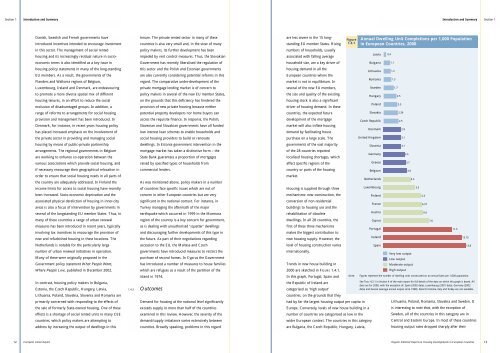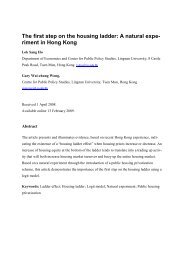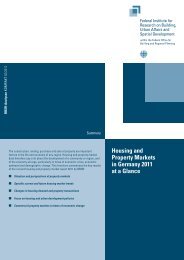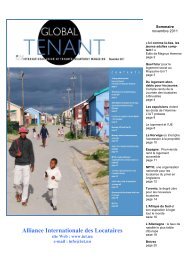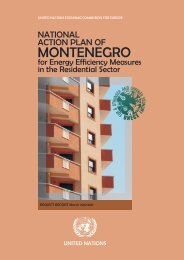housing developments in european countries - Department of ...
housing developments in european countries - Department of ...
housing developments in european countries - Department of ...
Create successful ePaper yourself
Turn your PDF publications into a flip-book with our unique Google optimized e-Paper software.
Section 1<br />
Introduction and Summary<br />
Introduction and Summary Section 1<br />
Danish, Swedish and French governments have<br />
<strong>in</strong>troduced <strong>in</strong>centives <strong>in</strong>tended to encourage <strong>in</strong>vestment<br />
<strong>in</strong> this sector. The management <strong>of</strong> social rented<br />
<strong>hous<strong>in</strong>g</strong> and its <strong>in</strong>creas<strong>in</strong>gly residual nature <strong>in</strong> socioeconomic<br />
terms is also identified as a key issue <strong>in</strong><br />
<strong>hous<strong>in</strong>g</strong> policy statements <strong>in</strong> many <strong>of</strong> the long-stand<strong>in</strong>g<br />
EU members. As a result, the governments <strong>of</strong> the<br />
Flanders and Wallonia regions <strong>of</strong> Belgium,<br />
Luxembourg, Ireland and Denmark, are endeavour<strong>in</strong>g<br />
to promote a more diverse spatial mix <strong>of</strong> different<br />
<strong>hous<strong>in</strong>g</strong> tenures, <strong>in</strong> an effort to reduce the social<br />
exclusion <strong>of</strong> disadvantaged groups. In addition, a<br />
range <strong>of</strong> reforms to arrangements for social <strong>hous<strong>in</strong>g</strong><br />
provision and management has been <strong>in</strong>troduced. In<br />
Denmark, for <strong>in</strong>stance, <strong>in</strong> recent years <strong>hous<strong>in</strong>g</strong> policy<br />
has placed <strong>in</strong>creased emphasis on the <strong>in</strong>volvement <strong>of</strong><br />
the private sector <strong>in</strong> provid<strong>in</strong>g and manag<strong>in</strong>g social<br />
<strong>hous<strong>in</strong>g</strong> by means <strong>of</strong> public-private partnership<br />
arrangements. The regional governments <strong>in</strong> Belgium<br />
are work<strong>in</strong>g to enhance co-operation between the<br />
various associations which provide social <strong>hous<strong>in</strong>g</strong>, and<br />
if necessary encourage their geographical relocation <strong>in</strong><br />
order to ensure that social <strong>hous<strong>in</strong>g</strong> needs <strong>in</strong> all parts <strong>of</strong><br />
the country are adequately addressed. In F<strong>in</strong>land the<br />
<strong>in</strong>come limits for access to social <strong>hous<strong>in</strong>g</strong> have recently<br />
been <strong>in</strong>creased. Socio-economic deprivation and the<br />
associated physical dereliction <strong>of</strong> <strong>hous<strong>in</strong>g</strong> <strong>in</strong> <strong>in</strong>ner-city<br />
areas is also a focus <strong>of</strong> <strong>in</strong>tervention by governments <strong>in</strong><br />
several <strong>of</strong> the longstand<strong>in</strong>g EU member States. Thus, <strong>in</strong><br />
many <strong>of</strong> these <strong>countries</strong> a range <strong>of</strong> urban renewal<br />
measures has been <strong>in</strong>troduced <strong>in</strong> recent years, typically<br />
<strong>in</strong>volv<strong>in</strong>g tax <strong>in</strong>centives to encourage the provision <strong>of</strong><br />
new and refurbished <strong>hous<strong>in</strong>g</strong> <strong>in</strong> these locations. The<br />
Netherlands is notable for the particularly large<br />
number <strong>of</strong> urban renewal <strong>in</strong>itiatives <strong>in</strong> operation.<br />
Many <strong>of</strong> these were orig<strong>in</strong>ally proposed <strong>in</strong> the<br />
Government policy statement What People Want,<br />
Where People Live, published <strong>in</strong> December 2002.<br />
In contrast, <strong>hous<strong>in</strong>g</strong> policy makers <strong>in</strong> Bulgaria,<br />
Estonia, the Czech Republic, Hungary, Latvia,<br />
Lithuania, Poland, Slovakia, Slovenia and Romania are<br />
primarily concerned with respond<strong>in</strong>g to the effects <strong>of</strong><br />
the sale <strong>of</strong> formerly State-owned <strong>hous<strong>in</strong>g</strong>. One <strong>of</strong> these<br />
effects is a shortage <strong>of</strong> social rented units <strong>in</strong> many CEE<br />
<strong>countries</strong>, which policy makers are attempt<strong>in</strong>g to<br />
address by <strong>in</strong>creas<strong>in</strong>g the output <strong>of</strong> dwell<strong>in</strong>gs <strong>in</strong> this<br />
tenure. The private rented sector <strong>in</strong> many <strong>of</strong> these<br />
<strong>countries</strong> is also very small and, <strong>in</strong> the view <strong>of</strong> many<br />
policy makers, its further development has been<br />
impeded by rent control measures. Thus, the Slovakian<br />
Government has recently liberalised the regulation <strong>of</strong><br />
this sector and the Polish and Estonian governments<br />
are also currently consider<strong>in</strong>g potential reforms <strong>in</strong> this<br />
regard. The comparative under-development <strong>of</strong> the<br />
private mortgage lend<strong>in</strong>g market is <strong>of</strong> concern to<br />
policy makers <strong>in</strong> several <strong>of</strong> the new EU member States,<br />
on the grounds that this deficiency has h<strong>in</strong>dered the<br />
provision <strong>of</strong> new private <strong>hous<strong>in</strong>g</strong> because neither<br />
potential property developers nor home buyers can<br />
access the requisite f<strong>in</strong>ance. In response, the Polish,<br />
Slovenian and Slovakian governments have all funded<br />
low <strong>in</strong>terest loan schemes to enable households and<br />
social <strong>hous<strong>in</strong>g</strong> providers to build or renovate<br />
dwell<strong>in</strong>gs. In Estonia government <strong>in</strong>tervention <strong>in</strong> the<br />
mortgage market has taken a dist<strong>in</strong>ctive form – the<br />
State Bank guarantees a proportion <strong>of</strong> mortgages<br />
raised by specified types <strong>of</strong> households from<br />
commercial lenders.<br />
As was mentioned above, policy makers <strong>in</strong> a number<br />
<strong>of</strong> <strong>countries</strong> face specific issues which are not <strong>of</strong><br />
concern <strong>in</strong> other European <strong>countries</strong> but are very<br />
significant <strong>in</strong> the national context. For <strong>in</strong>stance, <strong>in</strong><br />
Turkey manag<strong>in</strong>g the aftermath <strong>of</strong> the major<br />
earthquake which occurred <strong>in</strong> 1999 <strong>in</strong> the Marmara<br />
region <strong>of</strong> the country is a key concern for government,<br />
as is deal<strong>in</strong>g with unauthorised ‘squatter’ dwell<strong>in</strong>gs<br />
and discourag<strong>in</strong>g further <strong>developments</strong> <strong>of</strong> this type <strong>in</strong><br />
the future. As part <strong>of</strong> their negotiations regard<strong>in</strong>g<br />
accession to the EU, the Maltese and Czech<br />
governments have <strong>in</strong>troduced measures to restrict the<br />
purchase <strong>of</strong> second homes. In Cyprus the Government<br />
has <strong>in</strong>troduced a number <strong>of</strong> measures to house families<br />
which are refugees as a result <strong>of</strong> the partition <strong>of</strong> the<br />
island <strong>in</strong> 1974.<br />
1.4.3 Outcomes<br />
Demand for <strong>hous<strong>in</strong>g</strong> at the national level significantly<br />
exceeds supply <strong>in</strong> more than half <strong>of</strong> the <strong>countries</strong><br />
exam<strong>in</strong>ed <strong>in</strong> this review. However, the severity <strong>of</strong> the<br />
demand/supply imbalance varies extensively between<br />
<strong>countries</strong>. Broadly speak<strong>in</strong>g, problems <strong>in</strong> this regard<br />
are less severe <strong>in</strong> the 15 longstand<strong>in</strong>g<br />
EU member States. Ris<strong>in</strong>g<br />
numbers <strong>of</strong> households, usually<br />
associated with fall<strong>in</strong>g average<br />
household size, are a key driver <strong>of</strong><br />
<strong>hous<strong>in</strong>g</strong> demand <strong>in</strong> all the<br />
European <strong>countries</strong> where the<br />
market is not <strong>in</strong> equilibrium. In<br />
several <strong>of</strong> the new EU members,<br />
the size and quality <strong>of</strong> the exist<strong>in</strong>g<br />
<strong>hous<strong>in</strong>g</strong> stock is also a significant<br />
driver <strong>of</strong> <strong>hous<strong>in</strong>g</strong> demand. In these<br />
<strong>countries</strong>, the expected future<br />
development <strong>of</strong> the mortgage<br />
market will also <strong>in</strong>flate <strong>hous<strong>in</strong>g</strong><br />
demand by facilitat<strong>in</strong>g house<br />
purchase on a large scale. The<br />
governments <strong>of</strong> the vast majority<br />
<strong>of</strong> the 28 <strong>countries</strong> reported<br />
localised <strong>hous<strong>in</strong>g</strong> shortages, which<br />
affect specific regions <strong>of</strong> the<br />
country or parts <strong>of</strong> the <strong>hous<strong>in</strong>g</strong><br />
market.<br />
Hous<strong>in</strong>g is supplied through three<br />
mechanisms: new construction, the<br />
conversion <strong>of</strong> non-residential<br />
build<strong>in</strong>gs to <strong>hous<strong>in</strong>g</strong> use and the<br />
rehabilitation <strong>of</strong> obsolete<br />
dwell<strong>in</strong>gs. In all 28 <strong>countries</strong>, the<br />
first <strong>of</strong> these three mechanisms<br />
makes the biggest contribution to<br />
new <strong>hous<strong>in</strong>g</strong> supply. However, the<br />
level <strong>of</strong> <strong>hous<strong>in</strong>g</strong> construction varies<br />
<strong>in</strong>ternationally.<br />
Figure<br />
1.4.1<br />
Trends <strong>in</strong> new house build<strong>in</strong>g <strong>in</strong><br />
2000 are sketched <strong>in</strong> FIGURE 1.4.1.<br />
In this graph, Portugal, Spa<strong>in</strong> and<br />
Note:<br />
the Republic <strong>of</strong> Ireland are<br />
categorised as ‘high output’<br />
<strong>countries</strong>, on the grounds that they<br />
had by far the largest <strong>hous<strong>in</strong>g</strong> output per capita <strong>in</strong><br />
Europe. Conversely, levels <strong>of</strong> new house build<strong>in</strong>g <strong>in</strong> a<br />
number <strong>of</strong> <strong>countries</strong> are categorised as low <strong>in</strong> the<br />
wider European context. The <strong>countries</strong> <strong>in</strong> this category<br />
are Bulgaria, the Czech Republic, Hungary, Latvia,<br />
Annual Dwell<strong>in</strong>g Unit Completions per 1,000 Population<br />
<strong>in</strong> European Countries, 2000<br />
Latvia<br />
Bulgaria<br />
Lithuania<br />
Romania<br />
Sweden<br />
Hungary<br />
Poland<br />
Slovakia<br />
Czech Republic<br />
Denmark<br />
United K<strong>in</strong>gdom<br />
Slovenia<br />
Germany<br />
Greece<br />
Belgium<br />
Netherlands<br />
Luxembourg<br />
F<strong>in</strong>land<br />
France<br />
Austria<br />
Cyprus<br />
Portugal<br />
Ireland<br />
Spa<strong>in</strong><br />
0.4<br />
1.1<br />
1.2<br />
1.3<br />
1.7<br />
2.5<br />
2.3<br />
2.39<br />
2.5<br />
2.9<br />
3.1<br />
3.1<br />
3.5<br />
3.7<br />
3.9<br />
4.5<br />
Very low output<br />
Low output<br />
Moderate output<br />
High output<br />
Figures represent the number <strong>of</strong> dwell<strong>in</strong>g units constructed on an annual basis per 1,000 population.<br />
5.3<br />
See TABLE 4.2.1 <strong>in</strong> Section 4 <strong>of</strong> the ma<strong>in</strong> report for full details <strong>of</strong> the data on which this graph is based. All<br />
data are for 2000, with the exception <strong>of</strong>: Spa<strong>in</strong> (2002 data), Luxembourg (2001 data), Germany (2002<br />
data) and Greece (average annual output s<strong>in</strong>ce 1998). Data for Estonia, Italy and Turkey are not available.<br />
6.3<br />
6.37<br />
6.6<br />
7.6<br />
11.5<br />
13.15<br />
13.8<br />
Lithuania, Poland, Romania, Slovakia and Sweden. It<br />
is <strong>in</strong>terest<strong>in</strong>g to note that, with the exception <strong>of</strong><br />
Sweden, all <strong>of</strong> the <strong>countries</strong> <strong>in</strong> this category are <strong>in</strong><br />
Central and Eastern Europe. In most <strong>of</strong> these <strong>countries</strong><br />
<strong>hous<strong>in</strong>g</strong> output rates dropped sharply after their<br />
12 European Union Report<br />
Regular National Report on Hous<strong>in</strong>g Developments <strong>in</strong> European Countries<br />
13


